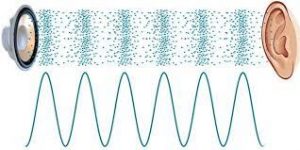What Direction Does Sound Travel?
What direction does sound travel? This is a question that has puzzled people for centuries. Sound vibrations travel through the air, but does that mean they travel down or up? Which direction does sound travel fastest? In this blog post, we will explore the answers to these questions and more!

Sound Waves
Sound is a type of energy that travels through the air, or any other medium, as a vibration of pressure waves. Sound can also travel through solid and liquid substances. The speed of sound is affected by the medium it is travelling through; for example, sound waves travel more slowly through water than they do through air.
There are two main types of sound waves: Longitudinal waves and Transverse waves. Longitudinal waves are created when the vibrations are in the same direction as the wave is moving. Transverse waves are created when the vibrations are at right angles to the direction in which the wave is moving. Sound waves are usually longitudinal because they travel faster and can carry more energy than transverse waves.
How Sound vibrations travel
How Sound vibrations travelling through solids
Sound travels fastest through solids, because the vibrations can travel through the solid material without being scattered. Sound travels more slowly through liquids, because the molecules in liquids are further apart than those in solids. Sound waves travel even more slowly through gases, because the molecules in gases are very far apart.
How Sound vibrations travelling through the air
The vibrating sound source moves in such a way that the air around it is also made to move. Imagine a drum skin being hit hard with a beater. The skin moves to one side and squashes or compresses the air next to it. This compressed air “pocket” in turn pushes and compresses the air next to it while the “pocket” itself bounces back towards the position it came from. The compressing effect and stretching effect therefore moves outwards from the sound source. The movement of the air back and forth is itself a rapid vibration and the movement of the effect outwards is in a wave form. Eventually the effect reaches the ear and is made into signals which are sent to the brain.
Does sound travel up or down?
So, does sound travel up or down? The answer is that it depends on the type of wave. Sound will always travel in a single direction until something blocks its route. The actual path of the sound waves is bent when they enter a new medium.
If a sound wave hits a hard surface, such as a wall, it will reflect off of that surface and travel in a different direction. If a sound wave hits a soft surface, such as a pillow, it will be absorbed by that surface and will not reflect.
Why does sound travel upward?
The ground warms (and cools) the air above it. The ground is generally warmer than the air above, so air temperature drops with height in the troposphere (up to about 8 miles). Because sound travels more quickly in hotter air, sound waves are refracted upward and away from the earth. Sound waves also bend around obstacles in their path. So, if you are standing behind a building or a hill, the sound waves will travel around that obstacle and reach your ears from the direction you would expect them to come from.
Sound can also travel up through ducts and pipes. When sound waves enter a pipe, they reflect off of the walls of the pipe and travel back down the pipe. These reflections continue until the sound waves reach the end of the pipe, where they are reflected again and travel back up the pipe. This process continues until the sound waves reach your ears.
Does sound travel more upstairs or downstairs?
Generally, sound travels in all directions. After all, you can hear your speakers even if they’re facing away from you, right? But while that’s technically true, you’ll probably hear more noise coming from above than below.
The same principles that apply to sound traveling up also apply to sound traveling downstairs. Sound waves are reflected off of the floor and travel back up the stairs. These reflections continue until the sound waves reach the top of the stairs, where they are reflected again and travel back down the stairs.
Final Remarks
So, what is the answer to our original question? Which direction does sound travel fastest? The answer may surprise you. Sound travels fastest in a straight line! However, this doesn’t mean that it can’t go around corners or through walls. In fact, sound waves will bend when they encounter an obstacle in their path. This is why we sometimes hear things from different directions depending on where we are standing in relation to the source of the noise. Next time you’re wondering how someone could have possibly heard something all the way across town, remember that sound travels much faster than you might think!